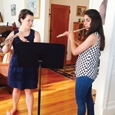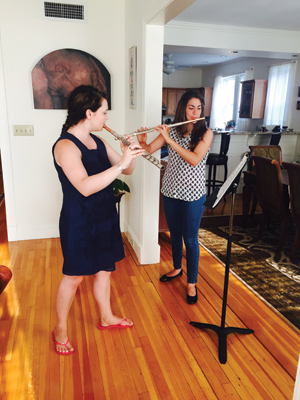 Partner practice is a beneficial, efficient, and fun way to break up a daily practice routine. At the Lawrence University Conservatory of Music, there is a long-standing tradition of older students mentoring younger ones through a practice buddy system. It is designed to help freshmen adapt to the university setting and learn how to meet conservatory expectations.
Partner practice is a beneficial, efficient, and fun way to break up a daily practice routine. At the Lawrence University Conservatory of Music, there is a long-standing tradition of older students mentoring younger ones through a practice buddy system. It is designed to help freshmen adapt to the university setting and learn how to meet conservatory expectations.
We became practice buddies last year when Cosette was a freshman and Schuyler was a senior. At first we alternated having one person play while the other listened and gave feedback. We later realized that it was more helpful to play together, as it led to a more fruitful practice session. We began to see great improvements in intonation, understanding of the music, phrasing, and sightreading. Additionally, we found that hearing an idea put in a different way by someone else often led to realizations that had a lasting impact on our playing. There are multiple ways to approach partner practice, including ping ponging, drone tuning, learning both flute parts in orchestral repertoire, and duet reading.
Ping Ponging
Rather than playing one long phrase, one person plays a small group or chunk of notes, and then the second person plays the next group, alternating groups through the phrase. On a second pass, the players switch roles, so both play all of the groups. This cluster of notes may be constructed in several ways such as by beat, by phrase, by measure, or by slur group. More advanced students may attempt to play these groups off the beat.
Scale
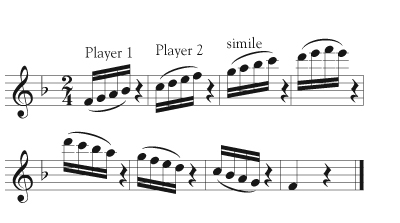
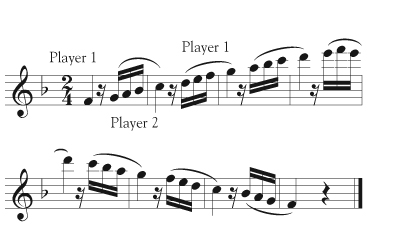
Thirds, alternating by measure

5-Note Patterns, alt. by 4s, 8s, 16s, etc.

Besides the examples above, players can ping pong arpeggios, seventh chords, broken seventh chords, modes, chromatic/whole tone/octatonic scales, and etudes. There are many benefits to this strategy. One of the most significant is the improvement in listening skills. Each flutist becomes more inclined to match the articulation, tone, tempo, and dynamics of the other. In addition, both players improve focus and concentration as they alternate groups.
This alternation also provides an opportunity learn how to comfortably begin the phase at different points. Playing both sets of groups leads to a stronger understanding of the phrase as a whole and may lead to a better way to play the phrase. It also highlights intervallic patterns that might be missed when playing the phrase as a whole and this can lead to more creative choices in using colors and inflection.
Flutists may also find better places in which to breathe due to the change in focus through this process. By playing in such small groups, it is easier to sense any awkwardness and diagnose problem areas. It also leads to faster progress in finger coordination. The brain tends to retain information better when learned in smaller chunks with a consistent system. This means that students will learn at a faster speed and attain a higher rate of retention.
Orchestral Repertoire
We also practiced our ensemble music together. We switched between first and second parts (or piccolo or alto) in order to learn the other part and better understand how the parts fit together. For example, as practice buddies, we have practiced Mendelssohn’s Symphony No. 4 and Ravel’s Daphnes et Chloé. In these practice sessions, we were able to address several issues, including listening to the other part, seeing how the parts fit together, understanding the harmony, resolving intonation issues, matching articulation, and maintaining balance, dynamics, tone, vibrato, and breathing. We often worked on well-known orchestral flute repertoire, which gave us a solid foundation when given the music in orchestra.
Duet Reading
In addition to ping ponging and orchestral repertoire, sightreading is a wonderful skill to develop during practice time. Working with a partner on duets makes it fun and also provides players with tools that they can use in solo, chamber, and orchestral repertoire. When another person is playing, one must keep moving in order to maintain the flow of the piece and learn to think quickly about the key signature, time signature, rhythm, and tempo. It also develops the ability to match one’s sound with another player which is important for orchestral playing. It can be very useful to have some duets ready to play as well – whether for auditions, competitions, or flute parties. (We sometimes added two or more flutes depending on the requirements of the piece.) We also found that by learning the style of a certain composer in a smaller work such as a flute duet, it was easier to play the style in a larger work by the same composer.
Intonation
Intonation is an ongoing battle that flutists often work on through drone tuning on a tuner. Another, more beneficial technique is to practice intonation while playing with another flutist. The sound is similar, so it is easier to match tones and hear intonation discrepancies. Additionally, practicing drone tuning with another flutist allows one to work on intonation both with and without vibrato, which is helpful for improving one’s intonation in a larger group setting. Partner practice on intonation also allows the players to work on balance. Often, we found that it was not a matter of being in tune, but of having the correct balance between the players. Balance can also be affected by a player’s use of vibrato. By working on vibrato with a partner, one can quickly discern whether the vibrato is too wide or too narrow. One way in which to work on this is by playing a whole-note scale in unison or at various intervals with the q=60. Both players could practice vibrato with 2, 3, 4, 5, or 6 vibrations per beat and listen for matching purposes.
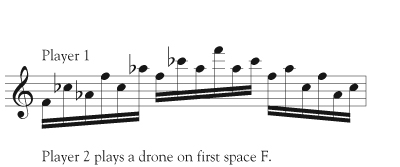
Combination tones or resultant tones occur when two loud tones are played at the same time. The frequency of the tone can either be the summation or difference of the two pitches. We practiced difference tones to work on intonation. Player one played a C6 while player two played an A6. The better we each played each of our notes, the stronger the lower pitch. We continued chromatically up the scale working for a ringing sound.
We also made an Intonation Tendency Chart for each note on the flute. Player one played a note without looking at the tuner, and player two, while looking at the tuner, notated on the chart the note’s pitch tendency. We repeated this process several times to be sure we had a solid idea about where the intonation on the instrument was. Before starting this process, it is important to check the headjoint cork and to pull the flute out to the proper place. To successfully accomplish ideal placement, assembling the flute in the right manner is key, as the embouchure hole must be level in order for the flute to remain in tune. Once the ideal placement is found, one may overblow low C, C# and D to be sure the first, second and fourth partials are in tune with themselves and with the tuner.
Practicing with a friend is a fun, productive way to improve your flute playing. See what creative strategies you come up with during your time with your practice partner and we hope you have as much fun as we did.

